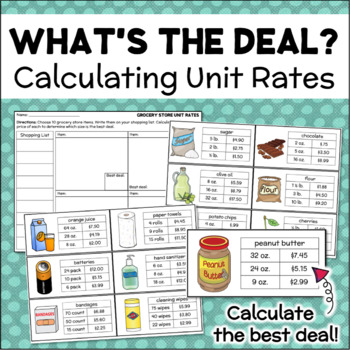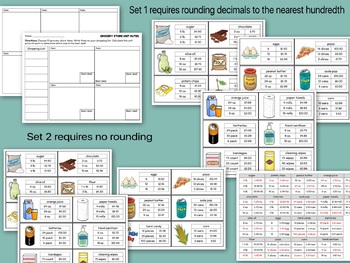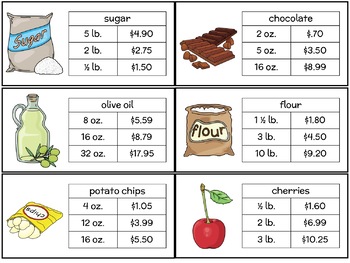Unit Rate - Calculating Unit Cost - Dividing & Rounding Decimals
The Classroom Gnat
453 Followers
Grade Levels
4th - 7th, Adult Education
Subjects
Resource Type
Standards
CCSS5.NBT.A.4
CCSS5.NBT.B.7
CCSS6.NS.B.3
CCSS6.RP.A.3
CCSS6.RP.A.3b
Formats Included
- PDF
Pages
14 pages
The Classroom Gnat
453 Followers
What educators are saying
This resource allowed my students to have fun with grocery shopping and finding unit rates. I like that it has real world implications and is reinforced what they learned in class.
This is a great activity for the students to practice better buys. I love that the students have a choice in the shopping list.
Description
This math activity gives students real-world experience with calculating unit rates. Instead of a bunch of random and meaningless math problems, your students will practice this skill in the context of shopping for groceries.
To complete this activity, students will choose 10 grocery items to build their shopping list. For each item selected, they must calculate the unit price of various package sizes to determine which is the best deal.
There are 2 sets of the grocery cards so you can differentiate for students at different levels.
• Set 1: Some cards require rounding decimals to the hundredths place to determine the unit cost.
• Set 2: All cards divide evenly to the hundredths place and require no rounding.
Both sets have the same answers to make grading easy.
Includes:
• 2 sets of grocery cards (36 cards total)
• Student work pages
• Answer key
Besides meaningful math practice, this activity teaches an important life skill and can be in adult education settings or life skills classes.
To complete this activity, students will choose 10 grocery items to build their shopping list. For each item selected, they must calculate the unit price of various package sizes to determine which is the best deal.
There are 2 sets of the grocery cards so you can differentiate for students at different levels.
• Set 1: Some cards require rounding decimals to the hundredths place to determine the unit cost.
• Set 2: All cards divide evenly to the hundredths place and require no rounding.
Both sets have the same answers to make grading easy.
Includes:
• 2 sets of grocery cards (36 cards total)
• Student work pages
• Answer key
Besides meaningful math practice, this activity teaches an important life skill and can be in adult education settings or life skills classes.
Total Pages
14 pages
Answer Key
Included
Teaching Duration
N/A
Report this resource to TPT
Reported resources will be reviewed by our team. Report this resource to let us know if this resource violates TPT’s content guidelines.
Standards
to see state-specific standards (only available in the US).
CCSS5.NBT.A.4
Use place value understanding to round decimals to any place.
CCSS5.NBT.B.7
Add, subtract, multiply, and divide decimals to hundredths, using concrete models or drawings and strategies based on place value, properties of operations, and/or the relationship between addition and subtraction; relate the strategy to a written method and explain the reasoning used.
CCSS6.NS.B.3
Fluently add, subtract, multiply, and divide multi-digit decimals using the standard algorithm for each operation.
CCSS6.RP.A.3
Use ratio and rate reasoning to solve real-world and mathematical problems, e.g., by reasoning about tables of equivalent ratios, tape diagrams, double number line diagrams, or equations.
CCSS6.RP.A.3b
Solve unit rate problems including those involving unit pricing and constant speed. For example, if it took 7 hours to mow 4 lawns, then at that rate, how many lawns could be mowed in 35 hours? At what rate were lawns being mowed?




